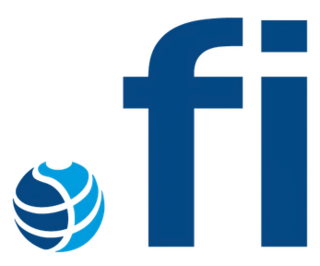A top-level domain (TLD) is one of the domains at the highest level in the hierarchical Domain Name System of the Internet after the root domain. The top-level domain names are installed in the root zone of the name space. For all domains in lower levels, it is the last part of the domain name, that is, the last non empty label of a fully qualified domain name. For example, in the domain name www.example.com, the top-level domain is .com. Responsibility for management of most top-level domains is delegated to specific organizations by the ICANN, an Internet multi-stakeholder community, which operates the Internet Assigned Numbers Authority (IANA), and is in charge of maintaining the DNS root zone.

The domain name .org is a generic top-level domain (gTLD) of the Domain Name System (DNS) used on the Internet. The name is truncated from 'organization'. It was one of the original domains established in 1985, and has been operated by the Public Interest Registry since 2003. The domain was originally "intended as the miscellaneous TLD for organizations that didn't fit anywhere else." It is commonly used by non-profit organizations, open-source projects, and communities, but is an open domain that can be used by anyone. The number of registered domains in .org has increased from fewer than one million in the 1990s, to ten million in 2012, and held steady between ten and eleven million since then.
A domain name registrar is a company that manages the reservation of Internet domain names. A domain name registrar must be accredited by a generic top-level domain (gTLD) registry or a country code top-level domain (ccTLD) registry. A registrar operates in accordance with the guidelines of the designated domain name registries.
.ca is the Internet country code top-level domain (ccTLD) for Canada. The domain name registry that operates it is the Canadian Internet Registration Authority (CIRA).

.uk is the Internet country code top-level domain (ccTLD) for the United Kingdom. It was first registered in July 1985, seven months after the original generic top-level domains such as .com and the first country code after .us.

.ee is the internet country code top-level domain (ccTLD) of Estonia, operated by the Estonian Internet Foundation.

.nu is the Internet country code top-level domain (ccTLD) assigned to the island state of Niue. It was one of the first ccTLDs to be marketed to the Internet at large as an alternative to the gTLDs .com, .net, and .org. Playing on the phonetic similarity between nu and new in English, and the fact that nu means "now" in several northern European languages, it was promoted as a new TLD with an abundance of good domain names available. The .nu domain is now controlled by the Internet Foundation in Sweden amid opposition from the government of Niue.

.fi is the Internet country code top-level domain (ccTLD) for Finland. It is operated by TRAFICOM, the Finnish Transport and Communications Agency.
A country code top-level domain (ccTLD) is an Internet top-level domain generally used or reserved for a country, sovereign state, or dependent territory identified with a country code. All ASCII ccTLD identifiers are two letters long, and all two-letter top-level domains are ccTLDs.

.cl is the Internet country code top-level domain (ccTLD) for Chile. It was created in 1987 and is administered by the University of Chile. Registration of second-level domains under this TLD is open to anyone, as established by the current regulation for the operation of the Domain Name Registration .CL since December 2013, which eliminated the requirement for foreign registrants to have a local contact with a RUN, the Chilean national identification number.
.qa is the Internet country code top-level domain (ccTLD) for State of Qatar.

.ua is the Internet country code top-level domain (ccTLD) for Ukraine. To register at the second-level (example) domainname.ua, possession of the exact trademark is required. It is not required for third-level domains.

.in is the Internet country code top-level domain (ccTLD) for India. It was made available in 1989, four years after original generic top-level domains such as .com, .net and the country code like .us. It is currently administered by the National Internet Exchange of India (NIXI).

.ly is the Internet country code top-level domain (ccTLD) for Libya.

.na is the Internet country code top-level domain (ccTLD) for Namibia corresponding to the two letter code from the ISO-3166 standard.
.no is the Internet country code top-level domain (ccTLD) for Norway. Norid, the domain name registry, is based in Trondheim, is owned by the state-owned Uninett and operates under supervision of the Norwegian Communications Authority. As of December 24, 2022 there were 843,749 registered .no domains. Organizations with a presence in Norway and registration at the Brønnøysund Register Centre are limited to 100 domains each. Individuals residing in Norway may register in the second-level domain priv.no and, as of June 17, 2014, directly under .no. Other second-level domains exist for organizations of certain types, such as municipalities and schools. The strict regulations have resulted in near-absence of cybersquatting and warehousing.
In the Domain Name System (DNS) hierarchy, a second-level domain is a domain that is directly below a top-level domain (TLD). For example, in example.com, example is the second-level domain of the .com TLD.
INRegistry is the organisation responsible for the .in TLD and the native language internationalised domain name TLDs for the country. It was appointed by the government of India, and operates under the authority National Internet Exchange of India (NIXI).
The Public Suffix List (PSL) is a community-maintained list of rules that describe the internet domain name suffixes under which independent organisations can register their own sites. Entries on the list are referred to as effective top-level domains (eTLDs), and contain commonly used suffixes like com, net and co.uk, as well as private suffixes like appspot.com and github.io.

.at is the Internet country code top-level domain (ccTLD) for Austria. It is administered by nic.at.











